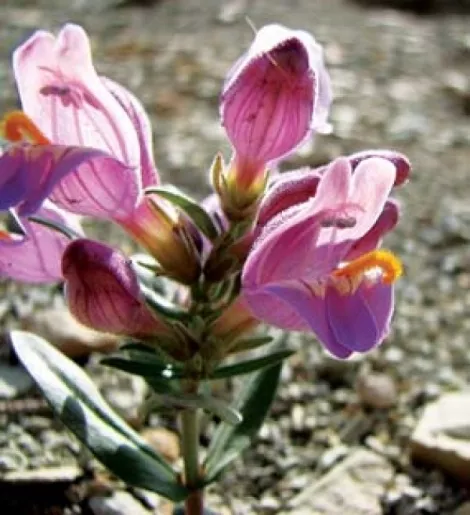
While the flower’s eligibility for listing as a federally protected endangered plant has been at issue for more than 30 years, conservationists say its future has been dicier than ever under the George W. Bush administration. A coalition of conservation agencies filed a federal lawsuit in Denver in late December, alleging the U.S. Bureau of Land Management and Fish and Wildlife Service (both administered by the Interior Department) ignored good science in failing to grant protected status to Graham’s under the Endangered Species Act. The Utah Native Plant Society, Southern Utah Wilderness Alliance, Colorado Native Plant Society and others seek to overturn a 2006 BLM decision not to list the flower, which they argue is threatened by booming energy development in Utah’s Uinta Basin.
Graham’s penstemon grows wild in only one known place in the world—on approximately 3,500 rugged acres in southern Uinta County and across the border in Rio Blanco County, Colo. Were Graham’s one of the 70 to 80 types of penstemon growing liberally in Utah’s open fields and xeriscaped gardens, its future wouldn’t be at issue. But the flower’s ultra-specific habitat is the rocky oil-shale fields now being eyed for exploration by Shell, Marathon and other U.S. oil company giants in Eastern Utah. A few years ago, when gas prices were relatively cheap, extracting oil shale seemed only a remote possibility, says Tony Frates, conservation co-chairman of the Utah Native Plant Society. But with Congress voting last fall to lift a ban on oil-shale exploration in the United States, things have changed.
“Utah has very unique geology. The harsh badlands we have in much of the state produce specific species that flourish in remote geologic outcrops,” Frates says.
The tug over listing Graham’s is growing nasty. Based on hundreds of pages of scientific testimony from botanists, rare plant and pollination experts, the U.S. Fish and Wildlife Service determined two years ago to list the flower. But in May 2006, the BLM filed a 96-page comment essentially arguing that the science to protect the species didn’t exist. Fish and Wildlife abruptly overturned itself.
Conservation groups reacted in January 2007 by filing a Freedom of Information Act (FOIA) request to obtain documents—including e-mails—that led to the decision. It took nearly two years of litigation for the BLM to produce the requested documents, Frates says.
E-mails and paperwork released show detailed plans by former BLM director Kathleen Clark to block the listing of Graham’s penstemon. Evidence shows the BLM had created a “no-listing team” and a “penstemon strike force” in the lead-up to Fish and Wildlife reversing its decision. “Our evidence suggests strongly that [former Interior Department Secretary] Gale Norton told them to do this. It’s improper. Her job, all of their jobs, is to make decisions based on scientific evidence. And they didn’t,” Frates says.
Norton has since left the Bush cabinet and directs Colorado’s oil-shale development for Shell Oil Co.
Larry England, a botanist for 25 years with Utah’s Fish and Wildlife field office, says the department has not “thoroughly digested” the lawsuit it faces. But he strongly denies that Bush administration policies favoring oil companies had as much influence as conservation groups claim.
“The two interests of oil-shale development and the penstemon are intrinsically entwined,” England says. “Our charge is to use the best science available to make a listing determination. We took a cold, hard look at species biology and the potential threat of oil shale—and somewhat reluctantly, I might add.
“Because of its place in these outcroppings, this plant is inherently vulnerable. It’s one of the most beautiful plant species I know. But we have not been able to prove at this point that it deserves a critical habitat designation.”
England confesses that as a native plant lover, he has been “working behind the scenes for [Graham’s] long-term survival for years. “Sometimes, it’s difficult to align what you feel in your gut with what you can prove in the field.”
And so, pending the outcome of this lawsuit, Graham’s penstemon lives on, with no certain status. Frates, like many other environmentalists with similar wish lists, hopes the suit has bought time for the plant’s reconsideration under the Obama administration.
“We can hope,” he says.